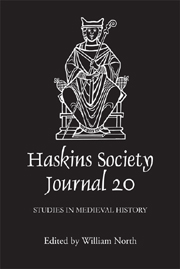Book contents
- Frontmatter
- Contents
- Editor's Note
- Abbreviations
- 1 Buckets, Monasteries, and Crannógs: Material Culture and the Rewriting of Early Medieval British History
- 2 Punishing Bodies and Saving Souls: Capital and Corporal Punishment in Late Anglo-Saxon England
- 3 Writing Latin History for a Lay Audience c. 1000: Dudo of Saint Quentin at the Norman Court
- 4 Between Neighbors and Saints: Waleran I of Meulan and the Allegiance of Lesser Lords in the Eleventh Century
- 5 Who Founded Durtal? Reconsidering the Evidence
- 6 Robert Curthose: Ineffectual Duke or Victim of Spin
- 7 The Chivalric Transformation and the Origins of Tournament as seen through Norman Chroniclers
- 8 An Internal Frontier? The Relationship between Mainland Southern Italy and Sicily in the ‘Norman’ Kingdom
- 9 ‘Hywel in the World’
- 10 Prices, Price Controls, and Market Forces in England under Edward I c. 1294–1307
1 - Buckets, Monasteries, and Crannógs: Material Culture and the Rewriting of Early Medieval British History
Published online by Cambridge University Press: 12 September 2012
- Frontmatter
- Contents
- Editor's Note
- Abbreviations
- 1 Buckets, Monasteries, and Crannógs: Material Culture and the Rewriting of Early Medieval British History
- 2 Punishing Bodies and Saving Souls: Capital and Corporal Punishment in Late Anglo-Saxon England
- 3 Writing Latin History for a Lay Audience c. 1000: Dudo of Saint Quentin at the Norman Court
- 4 Between Neighbors and Saints: Waleran I of Meulan and the Allegiance of Lesser Lords in the Eleventh Century
- 5 Who Founded Durtal? Reconsidering the Evidence
- 6 Robert Curthose: Ineffectual Duke or Victim of Spin
- 7 The Chivalric Transformation and the Origins of Tournament as seen through Norman Chroniclers
- 8 An Internal Frontier? The Relationship between Mainland Southern Italy and Sicily in the ‘Norman’ Kingdom
- 9 ‘Hywel in the World’
- 10 Prices, Price Controls, and Market Forces in England under Edward I c. 1294–1307
Summary
We want to begin this article by discussing lacunae. There are so many things we do not know about early medieval Britain. We have very little information, for example, on the beliefs, rituals and cultural practices of either pagans or early Christians in the fifth, sixth, and seventh centuries, because only a handful of texts survive that describe these years and most of these are retrospective reconstructions rather than contemporary accounts. Our few texts, moreover, were written for an elite audience by men who lived a monastic life removed from secular society, and because of this the texts we do have offer only the most fleeting glimpses of the millions of individuals who resided neither in monasteries nor in mead halls. Because of the way our evidence has survived, we also know less than we should about large parts of Britain that lay outside the English-culture zone. Peoples and places with extraordinary histories – Orkney, south Wales, south-western Scotland – have been assigned only the smallest walk-on parts in the narratives that we have constructed, because they appear in so few texts. Yet, even when we work on relatively well-documented subjects – such as early monasticism – in actual fact, we often know less than we think we do, because our ideas have been formed in essential ways by the single, dominating text of the period: Bede's Historia ecclesiastica gentis Anglorum.
Archaeologists, though, have unearthed the material remains of entire communities – settlements of farmers, Welsh-speakers, even early monks – and the evidence they have uncovered has the power to illuminate a much broader swath of society and geography than is typically included in our histories.
- Type
- Chapter
- Information
- The Haskins Society Journal 202008 - Studies in Medieval History, pp. 1 - 38Publisher: Boydell & BrewerPrint publication year: 2009



